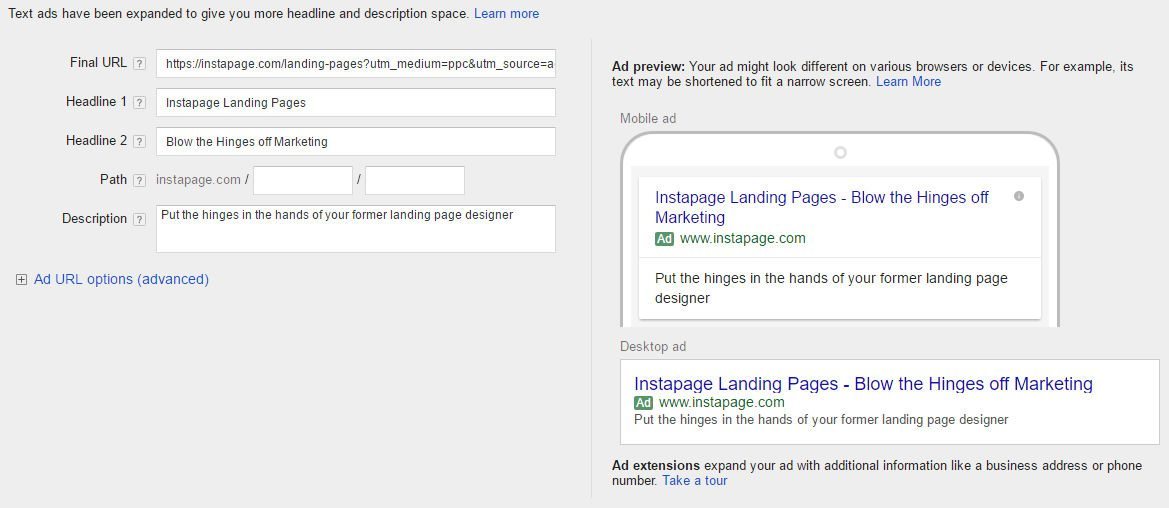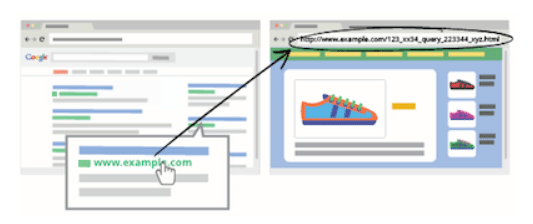In Google Ads paid search campaigns, two URLs require careful consideration: the display URL and the Google Ads final URL.
With a display URL, advertisers can show an easy-to-read URL that gives prospects a clear idea of where they’ll arrive once they click the ad. But with a final URL, you can define a more specific URL with rich tracking information:

Today’s article will take a closer look at Google Ads final URLs.
What is the Google Ads final URL?
Final URLs are just one component of two-part landing page URLs, which also includes a tracking template. For most advertisers, the landing page URL is the same as the final URL).
A Google Ads final URL is the website address people reach when they click your ad. This is required to create Google Ads. This type of URL is not visible on the ad, but the display URL is:

A tracking template, on the other hand, is optional. When a search user clicks your ad, the tracking template is used to create your complete landing page URL (more on this below).
Google Ads final URL mismatch, redirects, and tracking
“Do I need a final URL?” Yes, and the domain must match your display URL domain. Redirects within the same domain are allowed, but cross-domain redirects are not, and your ad can get disapproved by doing so. This is Google’s policy to ensure display URLs give searchers a clear, accurate idea of what page they’ll land on after clicking an ad—creating a better user experience.
For example, if a display URL reads www.mylandingpage.com, then the final URL can be as detailed as www.mylandingpage.com/abcde-12345, as long as the domains match. Yet a cross-domain redirect such as www.differentlandingpage.com/abcde-12345 will not get approval.
Using parameters (like “source=google” and “ad={creative}”) is another option, as these allow advertisers to track and record certain details about their ad once someone clicks it.
However, Google Ads’ upgraded URLs give advertisers increased control and specificity over how they define their final URL, and even
their tracking management. In addition, it’s no longer necessary to include tracking parameters in the “Final URL” field. This information is now entered into the “Tracking template” field instead:
![]()
Note: Although you may enter a simple, “clean” final URL into the “Final URL” field, the tracking code from the “Tracking template” field will automatically be added to the end of the URL when clicked. This means that your URL will no longer look clean and straightforward when users arrive at your destination page.
To demonstrate, here is an Instapage Google Ads ad for “landing page platforms” with the display URL: www.instapage.com.

The final URL is different from www.instapage.com because the tracking code makes it appear much longer like this:

Show me how Instapage works ➔.
How to insert keywords
To create the optimal landing page for prospects, Google Ads encourages advertisers to customize their final URLs for keywords. Customized keyword landing page URLs take people to landing pages that are highly-related to certain keywords.
Follow these steps to create customized keyword landing page URLs:
- Sign in to your Google Ads account
- In the page menu, click “Keywords”
- Scroll over the “Final URL” column of the keyword you want to specify a landing page for (add the column if necessary), and click the pencil icon
- Enter the URL (up to 2,048 characters)
- Click “Save”
For Google Analytics to provide details about your Google Ads keywords and costs, you must either enable auto-tagging or manually tag all of your keyword final URLs with tracking parameters:

Auto-tagging (Google recommended) automatically imports Google Ads data into Analytics. Combining this data with the rich Analytics data allows you to see how people engaged with your site or landing page after clicking your ads, ensuring you get the most detailed insights.
Is it okay to change the final URL in Google Ads?
The Ads Editor allows you to edit your final URL either one at a time or in bulk.
To change a URL in an ad group, the advanced URL changes tool is required. This tool enables advertisers to change final URLs, final mobile URLs, and tracking templates, all in bulk.
Specifically, it allows you to:
- Change all selected URLs to a new URL
- Add new text to all selected URLs
- Remove parameters from all selected URLs
To edit ads in bulk, follow these simple steps:
-
- Sign in to your Google Ads account
- In the page menu, click “Ads & extensions”
- Check the box next to all of the ads you want to edit (you can also select all ads at once by clicking the box in the menu)
- Click “Edit”, and then select “Change text ads”
- Make your changes, and then click “Preview” to see what your ad edits will look like, or click “Apply” to finalize all edits
Two more points need discussing here:
First, when adding a final URL to an existing ad, you must post the URL before posting the rest of the changes. Not doing this loses all ad stats and history since Google treats editing an ad the same thing as creating a new ad—completely removing the old version.
Second, instead of editing your ad, you should consider A/B testing new ads to determine how well different versions of your ad perform against one another. Doing this allows your original ad to stay running while the new versions start to perform.
Are final mobile URLs different from final desktop URLs?
Yes, final mobile URLs are different from final desktop URLs. The most well-known way to specify a mobile landing page is to use {device} and {ifmobile} ValueTrack parameters.
Another option, though, is to enter a separate, mobile-preferred URL, called a “final mobile URL.” In fact, even if your final URL contains {ifmobile} parameters, Google Ads still uses the final mobile URL for mobile devices. If for some reason, the final mobile URL is invalid, then it uses the final URL. Google Ads allows final mobile URLs for ads, sitelinks, keywords, and app extensions.
Google Ads final URL report
To thoroughly understand their performance, Google Ads provides a final URL report that functions as a anding page report exclusively for Google Ads traffic. This report shows any URLs to which you’ve directed prospects from Google Ads, allowing you to see which landing pages generate the most engagement and highest conversion rates.
The report includes all statistics aggregated at the final URL level. There is one row per final URL, and if other segment fields are used, there is more than one row per final URL. It’s important to note that the report doesn’t show any metrics for ad extensions.
Optimize the landing page
While display URLs are non-functioning, they serve an important decorative purpose for Google Ads—easily showing viewers the brand name and type of content to expect on the landing page. A final URL, on the other hand, is much more than just a visual component. It dictates where a person lands when they click your ad.
Since final URLs are the pages where you’re sending ad traffic, it’s critical that you create landing pages to improve the user experience and chance for conversions.
The Instapage platform enables marketers to create personalized, high-converting, customizable landing pages—faster and easier than ever. With personalization, AMP, an easy-to-use builder, team collaboration features, advanced A/B testing, and Instablocks™, no other platform compares. Sign up for an Instapage demo today.
